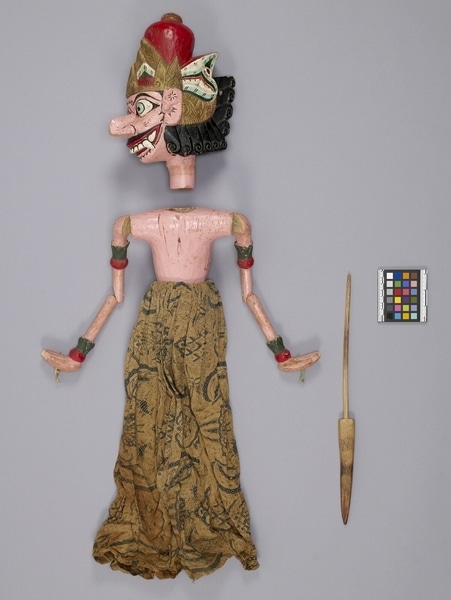Rod Puppet Item Number: Ib353 a-c from the MOA: University of British Columbia


Description
Three-dimensional male humanoid puppet: large head (part b) fits into body with skirt (part a), and a control rod (part c) with a long shaft that passes through the body and fits into the neck of the figure's head. The body has jointed arms, each with a long controlling rod attached. Figure has a pink face, arms and torso, wearing elaborate headdress and gathered skirt. Light blue staring eyes. Black moustache, red lips, big nose. Upper tooth row bared, upper and lower fangs present in both corners of mouth. Headdress composed of red cap with top knob, three-tiered gold crown with diadems in red, green and white, gold ear ornaments, Garuda Mungkur (mythical bird) mythical bird in white, light green, dark green and red. Ten black hair curls emerge from beneath crown. Green and red ornaments at wrists and upper arms. Long light brown and green batik skirt is gathered at waist. Arms jointed at shoulder and elbow. Arm control rods missing. Head movement controlled by removable rod, which extends from head to handle beneath skirt.
History Of Use
Javanese puppetry as an art form probably developed by the 11th century. The three-dimensional wooden wayang golek puppets of western Java appeared during the 16th century. Originally the plays depicted Javanese mythology, but after the Indian conquest of Java the Hindu epics, Ramayana and Mahabharata, were incorporated into the cycles, which comprise about 200 plays. An individual or group hires a dalang (puppet-master) to celebrate important occasions. The performances often last all night and are generally presented in three acts, with vocal and instrumental accompaniment. The individual plays vary widely in detail but usually involve conflict between good and evil. They serve a moral and religious purpose, and more recently, one of political commentary. Each puppet's character is represented by its appearance and placement onstage; protagonists with strong elements of good are placed to the right, antagonists of violent or evil nature to the left. Kumbakarna, the giant ogre, appears in the Ramayana cycle of plays. He is the brother of the main antagonist of the hero, Rama. Although he is an ogre and tending to evil, he is thought exemplify the virtue of loyalty more than any other wayang character. Ogres are considered foreigners although they are an indigenous Javanese adaptation of the Hindu epics upon which the plays are based.
Iconographic Meaning
Puppet displays several features characteristic of ogres: bulging blue eyes, large nose, fangs, other coarse features. Pale red face indicative of aggressiveness. However, elaborate crown, hair style. Position of hands bent at wrist, and batik skirt show some refinement and rank. Puppet identified as Kumbakarna on the basis of shape and components of crown, and large size relative to other puppets.
Cultural Context
Theatrical performance.
Item History
- Made in Java, Indonesia
- Owned by Tradewind Antiques before March 15, 1983
- Received from Museum of Anthropology Shop Volunteers (Funding source) and Tradewind Antiques (Seller) on March 15, 1983
What
- Name
- Rod Puppet
- Identification Number
- Ib353 a-c
- Type of Item
- puppet
- Material
- wood, cotton fibre, paint and synthetic fibre
- Manufacturing Technique
- carved, painted and sewn
- Part A
- height 59.0 cm, width 22.0 cm, depth 10.5 cm
- Part B
- height 27.5 cm, width 11.0 cm, depth 20.0 cm
- Part C
- height 40.0 cm, width 2.5 cm, depth 0.8 cm
Who
- Culture
- Sundanese
- Previous Owner
- Tradewind Antiques
- Received from
- Museum of Anthropology Shop Volunteers (Funding source) and Tradewind Antiques (Seller)
Where
- Holding Institution
- MOA: University of British Columbia
- Made in
- Java, Indonesia
When
- Ownership Date
- before March 15, 1983
- Acquisition Date
- on March 15, 1983
Other
- Condition
- fair
- Accession Number
- 0886/0087 a-c